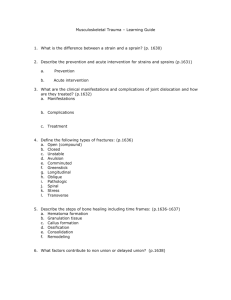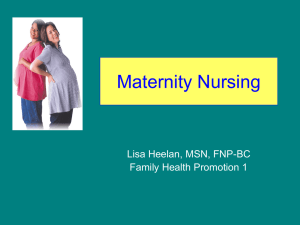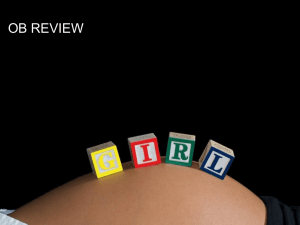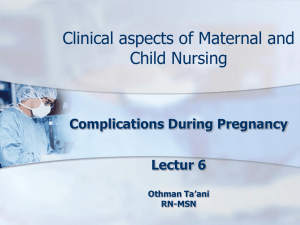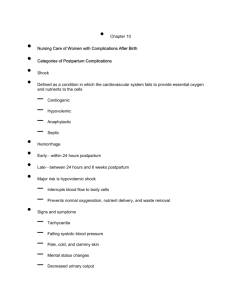IX. PREGNANCY AT RISK OBJECTIVES At the end of this class the
advertisement
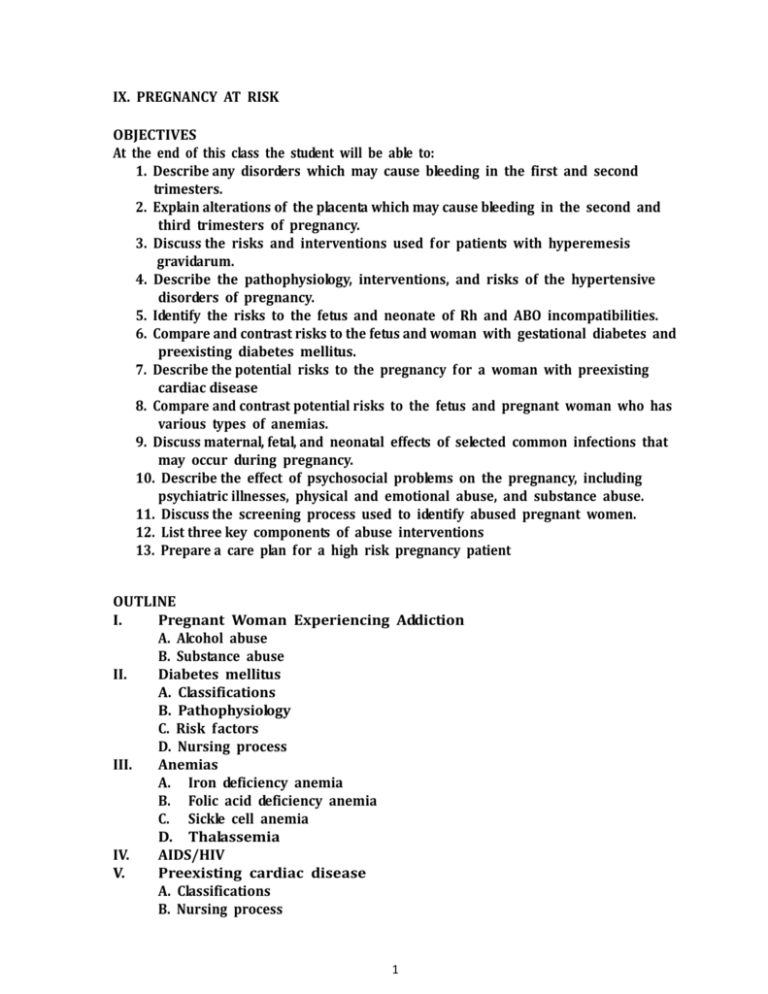
IX. PREGNANCY AT RISK OBJECTIVES At the end of this class the student will be able to: 1. Describe any disorders which may cause bleeding in the first and second trimesters. 2. Explain alterations of the placenta which may cause bleeding in the second and third trimesters of pregnancy. 3. Discuss the risks and interventions used for patients with hyperemesis gravidarum. 4. Describe the pathophysiology, interventions, and risks of the hypertensive disorders of pregnancy. 5. Identify the risks to the fetus and neonate of Rh and ABO incompatibilities. 6. Compare and contrast risks to the fetus and woman with gestational diabetes and preexisting diabetes mellitus. 7. Describe the potential risks to the pregnancy for a woman with preexisting cardiac disease 8. Compare and contrast potential risks to the fetus and pregnant woman who has various types of anemias. 9. Discuss maternal, fetal, and neonatal effects of selected common infections that may occur during pregnancy. 10. Describe the effect of psychosocial problems on the pregnancy, including psychiatric illnesses, physical and emotional abuse, and substance abuse. 11. Discuss the screening process used to identify abused pregnant women. 12. List three key components of abuse interventions 13. Prepare a care plan for a high risk pregnancy patient OUTLINE I. Pregnant Woman Experiencing Addiction A. Alcohol abuse B. Substance abuse II. Diabetes mellitus A. Classifications B. Pathophysiology C. Risk factors D. Nursing process III. Anemias A. Iron deficiency anemia B. Folic acid deficiency anemia C. Sickle cell anemia D. Thalassemia IV. AIDS/HIV V. Preexisting cardiac disease A. Classifications B. Nursing process 1 VI. Disorders Causing Bleeding in Early Pregnancy A. Spontaneous/elective abortion B. Ectopic pregnancy C. Gestational Trophoblastic Disease D. Hydatidiform Mole VII. Disorders Causing Bleeding in Later Pregnancy A. Placenta Previa B. Abruptio Placenta C. Nursing process for patients experiencing bleeding VIII. Hyperemesis gravidarum A. Risk factors B. Priority nursing care IX. Premature Rupture of the Membranes - PROM X. Hypertensive disorders of pregnancy A. Classification/ assessment B. Risk factors C. Pathophysiology D. Helip syndrome E. Nursing process F. Pharmacology and related nursing interventions XI. Maternal-fetal blood incompatibilities A. Rh incompatibility B. ABO incompatibility XII. Surgical Procedure 2 XIII. Trauma XIV. Maternal infections A. Classifications/types B. Risk factors C. Fetal risks D. Nursing process CRITICAL THINKING EXERCISES 1. A patient is assessed during a prenatal visit. Her blood pressure is 140/90. What other specific data should the nurse collect at this time? 2. A patient calls into the advice nurse center stating that she is bleeding. What other priority information does the nurse need to know before giving advice? 3 4 5 6 7 8 9 10 XI. COMPLICATIONS OF THE PUERPERIUM(Postpartum period) OBJECTIVES At the end of this class the student will be able to: 1. Describe postpartum hemorrhage in terms of risk factors, assessment and priority nursing interventions. 2. Identify complications of postpartum hemorrhage. 3. Explain associated factors, assessment and priority nursing interventions for subinvolution. 4. Compare and contrast thromboembolic disorders in term of predisposing factors, assessment and priority interventions. 5. Discuss puerperal infection in terms of location, risk factors, and priority interventions. 6. Describe major postpartal psychiatric disorders. 7. Apply the nursing process to a patient experiencing complications and alterations in homeostasis during the postpartum period. OUTLINE I. Postpartum hemorrhage A. Associated risk factors B. Early vs. late C. Complications D. Nursing care, including pharmacology II. Subinvolution of the uterus A. Risk factors B. Priority nursing interventions III. Infections A. Classifications B. Risk factors IV. Thromboembolic disorders A. Classifications B. Interventions C. Potential complications V. Psychiatric disorders A. Postpartum depression B. Postpartum psychosis C. Risk factors referrals D. Referrals 11 VI. Nursing Process A. History B. Assessment C. Diagnosis D. Interventions E. Patient teaching 12 13


